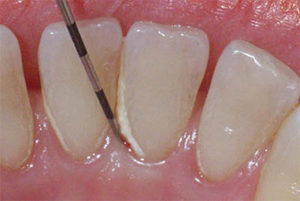
What is plaque?
Plaque is a sticky, yellow substance that naturally and constantly is forming on teeth. Plaque is made up of a complex microbial community with over ten billion bacteria per milligram. Each milligram contains approximately 400 different types of bacteria that produce acids. The bacterial products and acids combine with saliva to create an intricate matrix biofilm that contains proteins, lipids (fats), and sugars. This matrix also includes calcium and phosphorus.
The bacteria in plaque when kept in balance serves both positive and negative roles. When it is only on the teeth for short periods, it becomes part of the normal balance of the mouth. In fact, it can help build the human immune system. Having a healthy immune system is essential because it allows patients to fight off diseases.
What damage can this complex matrix do?
Plaque is constantly forming on tooth enamel. When the bacteria in plaque is not removed from your teeth, it forms an organized bacterial colony called a biofilm. When your hygiene regimen fails to disrupt the plaque matrix biofilm daily it can lead to bad breath, tooth decay, and gum disease.
When not cleaned, this biofilm will calcify and harden into tartar. As tartar collects on teeth, it encourages more plaque and tartar build up. Over time, this buildup above and below the gum line causes dental decay and gum disease.
Not removing plaque causes periodontal disease
Periodontal disease occurs along a continuum. In its most mild form, gingivitis, it is limited to the gum tissue surrounding your teeth. In the earliest stage, it may cause no symptoms. As it progresses, however, it can cause tender, red, swollen gums that bleed easily with brushing and flossing. Visiting your dentist and improving your hygiene habits can reverse gingivitis.
Left untreated, the bacteria and calculus build up below the gum line and cause pockets between the teeth and gums. These pockets allow for the build up of more harmful bacteria that can lead to infections, gum problems, and tooth loss. At this stage, it is known as periodontitis.
As this process progresses, the infection can get into your bloodstream and cause serious health issues, including heart disease, strokes, and diabetes. It can also lead to problems such as impotence, dementia, and infective endocarditis.
Once the infection goes below the gum line, it is too deep for a hygienist to reach with routine cleaning. To reduce the consequences of gum disease, your dentist may recommend deep cleaning with scaling and root planing. This treatment cleans below the gum line and removes the tartar and biofilm from pockets so your gums can heal.
After deep cleaning, you may be placed on a periodontal maintenance program with more frequent dental visits.
How to get rid of it
The bacterial biofilm remains on your tooth surfaces if you don’t take steps to remove it. This sticky colorless film needs to be removed daily.
Removal of the harmful bacteria requires good oral hygiene. That includes daily flossing and twice daily brushing with fluoride toothpaste to prevent plaque buildup. It is also important to keep up with routine dental visits and limit starches and sugars, especially between meals.
Other helpful measures include rinsing your mouth after eating, swishing with an antibacterial mouthwash, and proxy brushing.
How can my dentist help?
According to the American Dental Association (ADA), you should visit a dental professional at least twice a year. At these visits, your dentist and hygienist will perform a thorough examination that may include x-rays.
They will inspect for any signs of dental issues, such as dental decay, gum disease, or oral cancer. They will also perform professional teeth cleaning to remove the tartar or calculus that brushing and flossing cannot remove. Finally, they will polish your teeth to improve their appearance.
What if I have cavities?
If your dentist finds dental decay, he may recommend a filling. This simple procedure may require another dental appointment, but it should not take longer than an hour.
For a dental filling, your dentist will first numb the area for your comfort. He will then remove all of the decay and then restore the tooth with a filling. While there are several filling materials available, composite resin can be color matched to your natural teeth, so it is practically invisible.
If your dental decay goes beyond the surface of your tooth, you may need root canal therapy. This treatment is more complex and involves cleaning everything out of the root of your tooth. It may sound scary and painful, but anesthetic options can relieve you of any potential discomfort.
Because a root canal weakens the tooth and removes the nerves, you will need a dental crown to restore the tooth. A temporary crown will be placed to protect the tooth while you wait for your customized crown from the dental lab.
Let your dentist explain what plaque is and how to get rid of it
When was the last time you visited a dentist? Has dental neglect left you with issues that may need treatment, such as a filling, root canal, or crown?
Maybe you are interested in restoring the beauty of your smile with teeth whitening, dental bonding, or porcelain veneers.
Whatever your dental needs are, your dentist can design a treatment plan that controls oral disease, stops its progress, and restores the damage.
